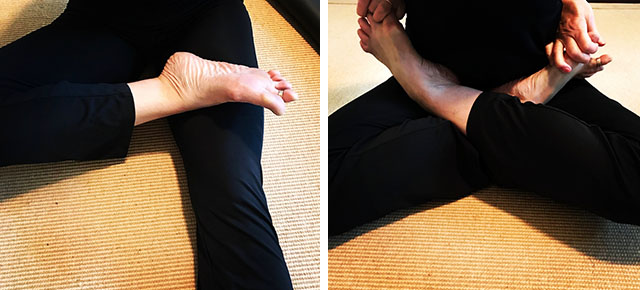 As many of you know, in addition to media/presentation training, I am also a teacher of Ashtanga yoga.
As many of you know, in addition to media/presentation training, I am also a teacher of Ashtanga yoga.
This past Monday, I was working with a few new students who were exploring getting themselves into the traditional lotus posture. (Picture above)
As you might imagine getting yourself into lotus properly takes some doing, as it requires quite a bit of hip flexibility and a certain amount of ankle flexibility. What it does not require, however, is “knee flexibility” (FYI: there is no such thing. Knees are not meant to be “flexible.” They are hinge joints. By the way, you also don’t want “elbow flexibility.”)
Given that, when teaching lotus there is a lot of pausing to make sure knees have not been compromised. In the case of my Monday students, they agreed their knees felt fine but what was bothering them was the pressure of their foot on the top of their quadriceps as they attempted the pose. (See picture on the left, below.)
As the goal of this post is not to teach you how to get into lotus, but instead to take the yoga conversation off the mat and into the business world, I will not walk you through the remainder of how to razzle-dazzle yourself into lotus.
What I will do is to point out that during the learning process, pressure on the quadriceps is OK— it’s just pressure. When the hip and ankle become more flexible, it’s no longer a factor because your foot can slide into the correct position. (See picture on the right, below.)
What got me thinking, however, was how often we—in any context—view pressure in a negative way. We say, “Things are tough– I’m under a lot of pressure at work,” or “I don’t want to pressure so-and-so.”
My question for today is, “Why?” If pressure is, in fact, something that is going to be relieved—and leaves no damage—when other factors fall into place, what is the problem with feeling pressure?
With this in mind, then, I’m writing to remind you—the next time you are feeling pressured—to change the way you hold that concept. To say, “Yep, I’m under pressure at the moment. That’s cool. It will change when X factor changes.”
Or, should you need to apply pressure to your team due to a specific project or circumstance, to present it to them as, “Things are going to be uncomfortable for a bit, but when Y situation changes, this will be relieved.”
My hope is that beginning to accept pressure as a necessary—and harmless—pit stop on the way to success will make it easier for you to experience it with equanimity.
For more on the value of embracing pressure, you might check out “Let Them See You Sweat”.

